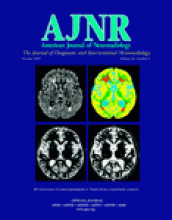Research ArticleBrain
Hyperintense Putaminal Rim Sign Is Not a Hallmark of Multiple System Atrophy at 3T
Wei-Hsing Lee, Chau-Chin Lee, Woei-Cherng Shyu, Pau-Nyen Chong and Shinn-Zong Lin
American Journal of Neuroradiology October 2005, 26 (9) 2238-2242;
Wei-Hsing Lee
Chau-Chin Lee
Woei-Cherng Shyu
Pau-Nyen Chong

References
- ↵Watanabe H, Saito Y, Terao S, et al. Progression and prognosis in multiple system atrophy: an analysis of 230 Japanese patients. Brain 2002;125:1070–1083
- ↵Quinn N, Marsden CD, Fahn S, ed. Multiple system atrophy: movement disorder. Oxford: Butterworth–Heinemann1994;262–281
- ↵Hughes AJ, Ben-Shlomo Y, Daniel SE, Lees AJ. What features improve the accuracy of clinical diagnosis in Parkinson’s disease: a clinicopathologic study. Neurology 1992;42:1142–1146
- ↵Litvan I, Goetz CG, Jankovic J, et al. What is the accuracy of the clinical diagnosis of multiple system atrophy? A clinicopathologic study. Arch Neurol 1997;54:937–944
- ↵Wenning GK, Tison F, Ben-Shlomo Y, et al. Multiple system atrophy: a review of 203 pathologically proven cases. Mov Disord 1997;12:133–147
- ↵Savoiardo M, Strada L, Girotti F, et al. Olivopontocerebellar atrophy: MR diagnosis and relationship to multisystem atrophy. Radiology 1990;174:693–696
- ↵Schrag A, Kingsley D, Phatouros C, et al. Clinical usefulness of magnetic resonance imaging in multiple system atrophy. J Neurol Neurosurg Psychiatry 1998;65:65–71
- ↵Schrag A, Good CD, Miszkiel K, et al. Differentiation of atypical Parkinsonian syndromes with routine MRI. Neurology 2000;54:697–702
- ↵Kraft E, Schwarz J, Trenkwalder C, et al. The combination of hypointense and hyperintense signal changes on T2-weighted magnetic resonance imaging sequences: a specific marker of multiple system atrophy? Arch Neurol 1999;56:225–228
- ↵
- ↵Macia F, Yekhlef F, Ballan G, et al. T2-hyperintense lateral rim and hypointense putamen are typical but not exclusive of multiple system atrophy. Arch Neurol 2001;58:1024–1026
- ↵Bhattacharya K, Saadia D, Eisenkraft B, et al. Brain magnetic resonance imaging in multiple system atrophy and Parkinson disease. Arch Neurol 2002;59:835–842
- ↵Watanabe H, Fukatsu H, Hishikawa N, et al. Field strengths and sequences influence putaminal MRI findings in multiple system atrophy. Neurology 2004;62:671
- ↵Hashemi RH, Bradley WG Jr, Lisanti CJ. MRI: the basics. 2nd ed. Philadelphia: Lippincott Williams & Wilkins2004;190–199
- ↵Schwarz J, Weis S, Kraft E, et al. Signal changes on MRI and increase of reactive micro-astrogliosis and iron in the putamen of two patients with multiple system atrophy. J Neurol Neurosurg Psychiatry 1996;60:98–101
- ↵Lantos PL, Papp MI. Cellular pathology of multiple system atrophy: a review. J Neurol Neurosurg Psychiatry 1994;57:129–133
- ↵Konayaga M, Sakai M, Matsuoka Y, et al. Pathological correlate of the slitlike changes on MRI at the putaminal margin in multiple system atrophy. J Neurol 1999;246:142–143
- ↵Block SA, Bakshi R, FLAIR MRI of striatonigral degeneration. Neurology 2001;56:1200
- ↵Raz N, Rodrigue KM, Kennedy KM, et al. Differential aging of the human striatum: longitudinal evidence. AJNR Am J Neuroradiol 2003;24:1849–1856
- ↵
In this issue
Advertisement
Wei-Hsing Lee, Chau-Chin Lee, Woei-Cherng Shyu, Pau-Nyen Chong, Shinn-Zong Lin
Hyperintense Putaminal Rim Sign Is Not a Hallmark of Multiple System Atrophy at 3T
American Journal of Neuroradiology Oct 2005, 26 (9) 2238-2242;
0 Responses
Jump to section
Related Articles
- No related articles found.
Cited By...
This article has not yet been cited by articles in journals that are participating in Crossref Cited-by Linking.
More in this TOC Section
Similar Articles
Advertisement











